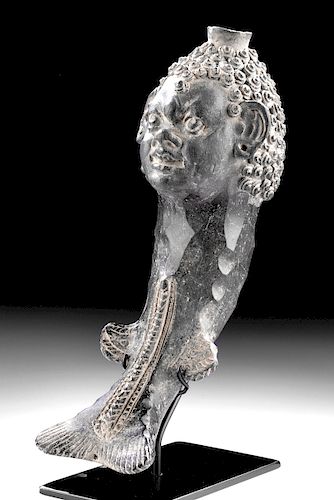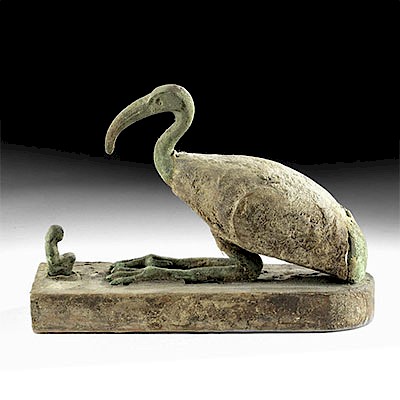Rare Sasanian Blackware Rhyton of Fish Man, TL Tested
Lot 103
About Seller
Artemis Gallery
686 S Taylor Ave, Ste 106
Louisville, CO 80027
United States
Selling antiquities, ancient and ethnographic art online since 1993, Artemis Gallery specializes in Classical Antiquities (Egyptian, Greek, Roman, Near Eastern), Asian, Pre-Columbian, African / Tribal / Oceanographic art. Our extensive inventory includes pottery, stone, metal, wood, glass and textil...Read more
Estimate:
$9,000 - $12,000
Absentee vs Live bid
Two ways to bid:
- Leave a max absentee bid and the platform will bid on your behalf up to your maximum bid during the live auction.
- Bid live during the auction and your bids will be submitted real-time to the auctioneer.
Bid Increments
| Price | Bid Increment |
|---|---|
| $0 | $25 |
| $300 | $50 |
| $1,000 | $100 |
| $2,000 | $250 |
| $5,000 | $500 |
| $10,000 | $1,000 |
| $20,000 | $2,500 |
| $50,000 | $5,000 |
| $100,000 | $10,000 |
| $200,000 | $20,000 |
About Auction
By Artemis Gallery
Oct 31, 2019
Set Reminder
2019-10-31 10:00:00
2019-10-31 10:00:00
America/New_York
Bidsquare
Bidsquare : Fine Antiquities, Asian, Ethnographic Art
https://www.bidsquare.com/auctions/artemis-gallery/fine-antiquities-asian-ethnographic-art-4581
Our Halloween Day auction features classical antiquities, ancient and ethnographic art from cultures encompassing the globe, plus fine art. Artemis Gallery info@artemisgallery.com
Our Halloween Day auction features classical antiquities, ancient and ethnographic art from cultures encompassing the globe, plus fine art. Artemis Gallery info@artemisgallery.com
- Lot Description
Ancient Near East, Sasanian or Hephthalite period, ca. late 5th to 7th century CE. A striking blackware rhyton depicting a fish-man/merman figure with a finely modeled human or deity head on the upper part of the vessel and a fish body with fins and tailfins forming the lower part of the vessel. Wine or libations would have been poured through the upper spout and would have exited via the hole at the center bottom of the fishtail. The meticulous workmanship and outstanding artistry resulted in a form that boasts remarkable details. Note the figure's coiffure with its corkscrew curls, his naturalistic ears pierced to decorate with ornaments, his bulging eyes, urna-like circular element on the forehead, wide fleshy nose, open mouth with two upper teeth delineated, pointed chin, and nicely rendered cheeks and facial contours. The fish body is also impressively delineated with recessed ovoid scales as well as incised and relief details on the central body and fins. Size: 10.625" H (27 cm); 10.25" H (26 cm) on included custom stand as it is positioned at an angle.
According to Ulf Jaeger's "Rhyton," Encyclopædia Iranica, online edition (2016), "Rhyta first appear in Iran, that is, in the geographical region where peoples of Iranian stock lived in antiquity (Svoboda, 1956; Frye, 1962, pp. 9-35; Frye, 1984, pp. 1-20), including Bactria, Chorasmia, Sogdiana, and the Tarim Basin of westernmost modern China. To the west, Iranians also lived in modern Turkey, as part of the Achaemenid empire, and into the Caucasus. In the Eurasian steppes, the Scythians and later the Sarmatians likewise were of Iranian stock. Another center of distribution for rhyta was the eastern Aegean area in the Bronze Age of Greece. The historical relationship of the distribution of rhyta in both areas is still under discussion (Koehl, 2006; Manassero, 2007)."
The term rhyton stems from a Greek verb that literally means "to run through". In fact, depictions of rhyta on Greek vases demonstrate that rhyta were used to aerate wine. Wine that was poured into the mouth of the vessel would have exited through the spout between the animal's legs (in this case tailfins). Rhytons like this example demonstrate the ancients' refined taste for special tableware, and this piece was probably used as a pouring vessel to aerate and decant wine into drinking bowls during festive occasions.
A similar Sasanian or Hephthalite period ceramic rhyton was found at Kohna Masjid, Afghanistan (figure 21 in Jaeger's article referenced above, originally published in "Arts Asiatiques," Tome 24, 1971, p. 6; D. Schlumberger, 1971). Its human head also presents the curly coiffure and other features found in Buddhist art created in Fondoqestan during the 6th to 7th century CE (Klimburg-Salter, 1989, pp. 73, 177-83) as stated by Jaeger.
This piece has been tested using thermoluminescence (TL) analysis and has been found to be ancient and of the period stated. A full report will accompany purchase.
Provenance: private Los Angeles, California USA collection, in USA since 1997
All items legal to buy/sell under U.S. Statute covering cultural patrimony Code 2600, CHAPTER 14, and are guaranteed to be as described or your money back.
A Certificate of Authenticity will accompany all winning bids.
We ship worldwide and handle all shipping in-house for your convenience.
#146844Chips to rim, fins, periphery of right ear (outer edge of left ear restored). Tiny TL holes on back of fish body and beneath lower hairline. Expected surface wear commensurate with age. Deposits grace the surface.Condition
- Shipping Info
-
All shipping is handled in-house for your convenience. Your invoice from Artemis Gallery will include shipping calculation instructions. If in doubt, please inquire BEFORE bidding for estimated shipping costs for individual items.
-
- Buyer's Premium



 EUR
EUR CAD
CAD AUD
AUD GBP
GBP MXN
MXN HKD
HKD CNY
CNY MYR
MYR SEK
SEK SGD
SGD CHF
CHF THB
THB














